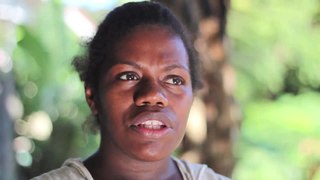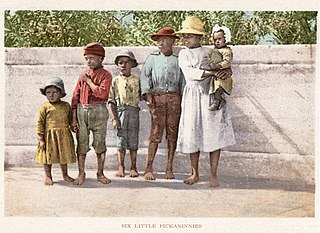Related Research Articles
A pidgin, or pidgin language, is a grammatically simplified means of communication that develops between two or more groups of people that do not have a language in common: typically, its vocabulary and grammar are limited and often drawn from several languages. It is most commonly employed in situations such as trade, or where both groups speak languages different from the language of the country in which they reside.

Tok Pisin, often referred to by English speakers as New Guinea Pidgin or simply Pidgin, is an English creole language spoken throughout Papua New Guinea. It is an official language of Papua New Guinea and the most widely used language in the country. However, in parts of the southern provinces of Western, Gulf, Central, Oro, and Milne Bay, the use of Tok Pisin has a shorter history and is less universal, especially among older people.

Bislama is an English-based creole language. It is the national language of Vanuatu, and one of the three official languages of the country, the other ones being English and French. Bislama is the first language of many of the "Urban ni-Vanuatu" and the second language of much of the rest of the country's residents. The lyrics of "Yumi, Yumi, Yumi", the country's national anthem, are composed in Bislama.

Torres Strait Creole, also known as Torres Strait Pidgin, Brokan/Broken, Cape York Creole, Lockhart Creole, Kriol, Papuan, Broken English, Blaikman, Big Thap, Pizin, and Ailan Tok, is an English-based creole language spoken on several Torres Strait Islands of Queensland, Australia; Northern Cape York; and south-western coastal Papua New Guinea (PNG).

Pickaninny is a pidgin word for a small child, possibly derived from the Portuguese pequenino. It has been used as a racial slur for African American children and a pejorative term for Aboriginal children of the Americas, Australia, and New Zealand. It can also refer to a derogatory caricature of a dark-skinned child of African descent.
Bugger or buggar can at times be considered as a mild swear word. In the United Kingdom the term has been used commonly to imply dissatisfaction, refer to someone or something whose behaviour is in some way inconvenient or perhaps as an expression of surprise. In the United States, particularly in the Midwest and South, it is an inoffensive slang term meaning "small animal".
Hiri Motu, also known as Police Motu, Pidgin Motu, or just Hiri, is a language of Papua New Guinea, which is spoken in surrounding areas of its capital city, Port Moresby.
Unserdeutsch, or Rabaul Creole German, is a German-based creole language that originated in Papua New Guinea as a lingua franca. The substrate language is assumed to be Tok Pisin, while the majority of the lexicon is from German.
An English-based creole language is a creole language for which English was the lexifier, meaning that at the time of its formation the vocabulary of English served as the basis for the majority of the creole's lexicon. Most English creoles were formed in British colonies, following the great expansion of British naval military power and trade in the 17th, 18th and 19th centuries. The main categories of English-based creoles are Atlantic and Pacific.
Japanese Pidgin English is any of several English-based pidgins spoken or influenced by the Japanese.
Samoan Plantation Pidgin is an extinct English-based pidgin language that was spoken by black plantation workers in Samoa. It is closely related to Tok Pisin, due to the large number of New Guinean laborers in Samoa.
The language bioprogram theory or language bioprogram hypothesis (LBH) is a theory arguing that the structural similarities between different creole languages cannot be solely attributed to their superstrate and substrate languages. As articulated mostly by Derek Bickerton, creolization occurs when the linguistic exposure of children in a community consists solely of a highly unstructured pidgin; these children use their innate language capacity to transform the pidgin, which characteristically has high syntactic variability, into a language with a highly structured grammar. As this capacity is universal, the grammars of these new languages have many similarities.
Bamboo English was a Japanese pidgin-English jargon developed after World War II that was spoken between American military personnel and Japanese on US military bases in occupied Japan. It has been thought to be a pidgin, though analysis of the language's features indicates it to be a pre-pidgin or a jargon rather than a stable pidgin.
According to the theory of monogenesis in its most radical form, all pidgins and creole languages of the world can be ultimately traced back to one linguistic variety. This idea was first formulated by Hugo Schuchardt in the late 19th century and popularized in the late 1950s and early 1960s by Taylor (1961) and Thompson (1961). It assumes that some type of pidgin language, dubbed West African Pidgin Portuguese, based on Portuguese was spoken from the 15th to 18th centuries in the forts established by the Portuguese on the West African coast. This variety was the starting point of all the pidgin and creole languages. This would explain to some extent why Portuguese lexical items can be found in many creoles, but more importantly, it would account for the numerous grammatical similarities shared by such languages.

Papua New Guinea, a sovereign state in Oceania, is the most linguistically diverse country in the world. According to Ethnologue, there are 840 living languages spoken in the country. In 2006, Papua New Guinea Prime Minister Sir Michael Somare stated that "Papua New Guinea has 832 living languages ."

Native languages of Oceania fall into three major geographic groups:
Papuan Pidgin English was a 19th-century English-based pidgin of New Guinea. It was eventually replaced by Hiri Motu, a Melanesian-based pidgin, and was not ancestral to modern English-based Tok Pisin.
Melanesian Pidgin or Neo-Melanesian language comprises four related English-derived languages of Melanesia:
References
- Smith, Norval (1994). "An annotated list of creoles, pidgins, and mixed languages". In Jacque Arends, Pieter Muysken & Norval Smith (ed.). Pidgins and Creoles. John Benjamins.
- "American Italian". 2009.